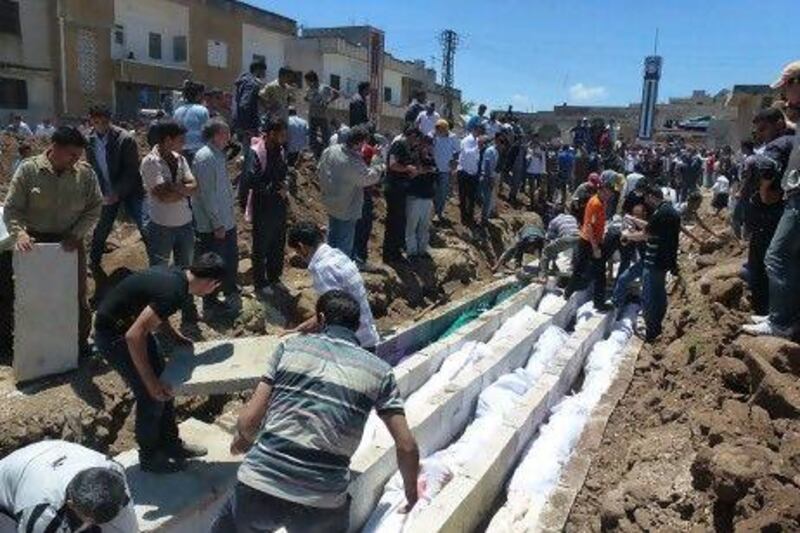DAMASCUS // Protests in Damascus are increasingly being marked by sectarianism, in particular a growth of anti-Alawite rhetoric and conservative Sunni ideals, according to secular and minority group activists.
Activists participating in some of the dozens of peaceful protests that take place each day in the Syrian capital and its suburbs say they have experienced a hardening of attitudes among demonstrators, especially following the May 25 Houla massacre.
More than 100 Sunni villagers were executed in Houla, with opposition groups holding a pro-regime Alawite militia, the shabbiha, responsible. Sunnis make up the majority of the country's population and form the backbone of the opposition trying to overthrow president Bashar Al Assad, who heads a regime dominated by Alawites, a minority sect of Shiite Islam.
The uprising has crossed ethnic and sectarian boundaries, with Alawites, as well as Christians, Druze, Ismailis and Kurds joining the campaign to topple the regime, while Mr Al Assad continues to enjoy vital support among Sunnis as well as from across the various minority groups.
Nonetheless, with the uprising now in its sixteenth month and with the death toll at about 15,000 - mostly civilians - a more or less dormant sectarianism has become increasingly pronounced, pitting a regime strongly identified as Alawite against an opposition that appears to be more strongly defining itself at street level as Sunni.
Those divisions have reached their deepest in Homs province - including Houla - with Alawites and Sunnis each accusing the other of sectarian bloodletting.
In Damascus the uprising has been slower to take hold, but protests, a violent crackdown by security forces and, increasingly, attacks by armed opposition rebels, have brought the capital firmly into the crisis.
On a number of occasions, anti-Alawite sentiments have crossed into outright hostility against Alawite dissidents taking part in the Damascus protests, despite the fact they are seasoned supporters of the uprising and have shared in the enormous risks of defying the Syrian authorities.
The activists involved said this was a new departure, with protesters in the city and its suburbs previously venerating members from the Alawite, Christian, Druze or Ismaili minority groups taking part in demonstrations.
"I was at a protest in Midan recently and the crowd with hundreds of people in it starting chanting that they would kill Alawites," said a protester, herself an Alawite and a regular participant in Midan's frequent demonstrations.
Midan, a prosperous middle-class neighbourhood just south of central Damascus, has been heavily involved in the revolt since it began last March.
"I shouted, 'Hey, I'm an Alawite, do you want to kill me too' and they apologised and started singing a different slogan but it was the first time I have heard them do that," she said.
At another demonstration, in Barzeh, a neighbourhood in northeastern Damascus, the protester said she and other activists from minority groups were told that women could only take part if they stood separately from the demonstrating men - segregation in accordance with conservative Islamic principles.
Dozens of protesters have been killed in Barzeh since the uprising began and sectarian tensions have been pointed in the area, which is close to Ash Al Warwar, an Alawite, and hardline pro-regime district.
Men and women had not always mixed in Barzeh's street rallies, the activist said, but minorities were treated as exceptions, with female Alawite and Druze protesters allowed to join the men if they chose.
"This last time I went they were angry with us and said we could not stand with the men, and we had an argument about it. I said if I'm marching, I'm not going to stand quietly in the corner with the women but they didn't accept that," she said.
Another Alawite protester, also a woman, said they were struggling to keep the uprising nonsectarian and focused on creating a civil, democratic state.
"More and more we go along and the chants are about Islam and that doesn't help ease the fears among the minorities who want to hear that we will all be equal in a democratic Syria, protected by civil laws," she said.
"When we hear the Islamic chants, we sing songs about Syrian unity, Syrian nationalism and freedom," she said. "Sometimes the other protesters join in with us, but sometimes they don't; they keep singing Islamic chants and we have the two chants competing against each other."
Divisions among the protesters widened in Kafa Susa, a largely Sunni neighbourhood in central Damascus, earlier this month, when minority group protesters were, as in Barzeh, told the demonstrations were now gender segregated.
"We argued a lot about that and they were so rude and aggressive that I was really shocked," said a young Alawite dissident who had taken part. "I've not been back there since, I felt we were not welcome anymore."
She said secular and minority group activists were involved in two revolutions, one against the regime and one against an increasing trend towards conservative Islam among demonstrators.
Sectarian identity politics is a complex issue in Syria, making it difficult to accurately quantify or predict how significant a role it may play in any future worsening of the conflict. The United Nations and western states have, however, warned the country is facing a sectarian civil war.
The activists who described negative expressions of sectarianism at protests said they still considered it to be the exception, not the rule. And they stressed their commitment to a revolution they said remained overwhelmingly a nonsectarian struggle for basic civil rights against an oppressive regime, not a conflict defined by religious ideology.
However, they said the signs of an emerging sectarianism were alarming and that they feared the direction the revolt would take, if the opposition failed to keep the sentiments in check.
"There is more sectarianism now, there is a problem between the Alawites and Sunnis, we have to admit that, it is present," said a leading Christian dissident in Damascus.
"But we cannot judge the entire revolution by some ill-conceived remarks made by protesters in the heat of the moment, with all the anger and blood that has been shed," he said. "This is still a revolution for justice and freedom, it is not sectarian in its heart, I am certain of that."
Secular activists, and those from minority groups, also said they continued to be welcomed at Sunni dominated protests, even in besieged districts such as Douma, north-east of Damascus, in Deraa, the crucible of the rebellion in southern Syria and Idleb province in the country's north - all Sunni heartlands embroiled now in civil war.
"We turned up, some Alawites and Druze, and when the people realised we were not Sunni they treated us like heroes, it was a privilege to be with them, there was unity," said a Druze protester who went to Douma for the recent burial of nine activists.
"They all sang, 'the Syrian people are one' and they were very happy to see us, to know we are with them and that is still the reaction we get in most places we go'."
A Sunni activist from Douma said sectarianism would not come to dominate the uprising.
"We all know that most of the security forces shooting at us and killing us are Sunnis, not Alawites, this is not about sect," he said. "Sect is not important, we are trying to overthrow the regime and we will oppose anyone who is with it, and we will be with anyone who is against it."





